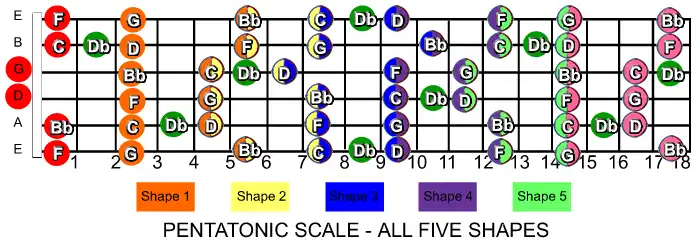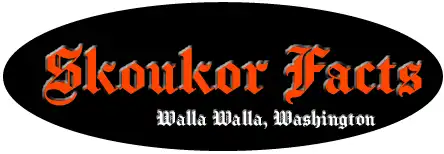Blue's Player's Five Pentatonic Shapes
By Vicki Lynn
Learning to connect the five pentatonic shapes across the fretboard is a great way to improve your lead guitar playing. The
pentatonic scale will help you learn to improvise freely and create solos across the entire neck of your guitar.
Take time to understand the scale. The minor pentatonic scale is the foundation of blues guitar lead solo playing. It is an
important scale and one that you will use extensively in your playing. It is important you learn the scale thoroughly.
Undoubtedly the most popular scale amongst blues guitarists is the minor pentatonic scale. The principles also apply to both the
blues scale and the major pentatonic scale.
There are five pentatonic shapes on the fretboard, which cross the entire length of the guitar fretboard as seen in the image.
These five pentatonic shapes repeat. After the fifth shape the next shape will be a repeat of the first shape, and so forth.

All the pentatonic shapes overlap. They connect with each other. And all shapes of the pentatonic scale contain notes found in
the other pentatonic scale shapes. Knowing the five pentatonic shapes will go a long way in helping you move around the guitar
fretboard.
The shapes of the minor pentatonic scale are always in the same order on your fretboard. If you are on shape 1 in any given key,
the next shape will be shape 2, and shape 3, and shape 4 repeating back to shape 1 after shape 5.
Once you know the order of the five pentatonic shapes, and an idea of how the five pentatonic shapes stretch across the fretboard,
you will want to start learning how the shapes overlap and connect.
This image shows all five pentatonic shapes are not separate. They are all connected, and they all share notes with each other.
There are many crossovers between the shapes and many areas are connected.

Begin with shape one and play the pentatonic scale notes until you are content with your knowledge. After you have learned shape
one, start learning shape two, and while working with shape two, find ways to connect the two shapes together that work best for
you. Do not worry about the different connection points, find the connection points between the shapes which work for your musical
ear.
Following the image the D note, highlighted yellow and purple (between shapes 2 & 3), on the G string, 7th fret will be our
starting point in our example. This is a good connection point in two minor pentatonic shapes.
In shape two you play the note with your third finger and in shape three you play the same note with your first finger. The key
is to switch back and forth between the two shapes perfectly.
For solo work learning the shape's connection points on the top treble strings G, B and E strings are important. The connection
notes on these strings form pentatonic boxes. It is highly recommended that you learn different pentatonic box shapes. You can
connect the five pentatonic shapes by moving down the fretboard through the box shapes.
Add Comment
Insert Bullet List
Please enter at least one item.
Item:
Item:
Item:
Item:
Item:
Insert Numeric List
Please enter at least one item.
Item:
Item:
Item:
Item:
Item:
Insert Link
Please enter the link of the website
Optionally you can add display text
Insert Email
Please enter the email address
Optionally add any display text
Insert Image
Please enter the link of the image
Insert YouTube Video
Please enter the link of the video
Image Upload
Privacy Policy
This policy contains information about your privacy. By posting, you are declaring that you understand this policy:
- Your name, rating, website address, town, country, state and comment will be publicly displayed if entered.
- Aside from the data entered into these form fields, other stored data about your comment will include:
- Your IP address (not displayed)
- The time/date of your submission (displayed)
- Your email address will not be shared. It is collected for only two reasons:
- Administrative purposes, should a need to contact you arise.
- To inform you of new comments, should you subscribe to receive notifications.
- A cookie may be set on your computer. This is used to remember your inputs. It will expire by itself.
This policy is subject to change at any time and without notice.
Terms and Conditions
These terms and conditions contain rules about posting comments. By submitting a comment, you are declaring that you agree with these rules:
- Although the administrator will attempt to moderate comments, it is impossible for every comment to have been moderated at any given time.
- You acknowledge that all comments express the views and opinions of the original author and not those of the administrator.
- You agree not to post any material which is knowingly false, obscene, hateful, threatening, harassing or invasive of a person's privacy.
- The administrator has the right to edit, move or remove any comment for any reason and without notice.
Failure to comply with these rules may result in being banned from submitting further comments.
These terms and conditions are subject to change at any time and without notice.
{"commentics_url":"\/\/skoukor.com\/cmt\/","page_id":374,"enabled_country":true,"country_id":0,"enabled_state":true,"state_id":0,"enabled_upload":true,"maximum_upload_amount":3,"maximum_upload_size":5,"maximum_upload_total":5,"captcha":false,"captcha_url":"","cmtx_wait_for_comment":"cmtx_wait_for_comment","lang_error_file_num":"A maximum of %d files are allowed to be uploaded","lang_error_file_size":"Please upload files no bigger than %.1f MB in size","lang_error_file_total":"The total size of all files must be less than %.1f MB","lang_error_file_type":"Only image file types are allowed to be uploaded","lang_text_loading":"Loading ..","lang_placeholder_country":"Country","lang_placeholder_state":"State","lang_text_country_first":"Please select a country first","lang_button_submit":"Add Comment","lang_button_preview":"Preview","lang_button_remove":"Remove","lang_button_processing":"Please Wait.."}
{"commentics_url":"\/\/skoukor.com\/cmt\/","language":"english"}
|
Copyright © Skoukor Music 2025
|
||

|
||


Comments